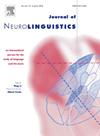What's the point of talking? Auditory targets and communicative goals
IF 1.2
3区 心理学
Q2 LINGUISTICS
引用次数: 0
Abstract
Human speech production is a complex action requiring minute control over the articulators and sensitivity to the surrounding environment. Computational and empirical work has attempted to identify the specific neural mechanisms and cognitive processes that allow us to reliably produce speech sounds. This work has established that humans can use their perception of the auditory and somatosensory consequences of their actions to guide subsequent speech movements. However, speech predominantly takes place in a communicative context, and this context is also known to modulate the way that people speak: human voices are highly flexible. In this paper, we try to unite the traditional motor control conception of internally defined acoustic and somatosensory goals with linguistic research showing that talkers respond and entrain to their conversational partners. We provide an overview of the theoretical and empirical work surrounding the use of sensory feedback monitoring in speech production and discuss practical constraints that have limited more naturalistic investigations into dyadic interaction. To conclude, we argue that the variability of results seen in the speech motor control literature reflects a more complex underlying neural architecture, and an overarching communicative goal that supersedes specific phonetic targets.
谈话有什么意义?听觉目标和交际目标
人类语言的产生是一个复杂的动作,需要对发音器和对周围环境的敏感性进行细致的控制。计算和实证工作试图确定特定的神经机制和认知过程,使我们能够可靠地产生语音。这项工作已经证明,人类可以利用他们对自己行为的听觉和体感后果的感知来指导随后的语言运动。然而,言语主要发生在交际环境中,这种环境也会调节人们说话的方式:人类的声音是高度灵活的。在本文中,我们试图将传统的运动控制概念(内部定义的声学和体感目标)与语言研究结合起来,表明说话者对其对话伙伴做出反应和吸引。我们概述了围绕在语音产生中使用感官反馈监测的理论和实证工作,并讨论了限制对二元交互进行更自然研究的实际限制。总之,我们认为在言语运动控制文献中看到的结果的可变性反映了一个更复杂的潜在神经结构,以及一个取代特定语音目标的总体交际目标。
本文章由计算机程序翻译,如有差异,请以英文原文为准。
求助全文
约1分钟内获得全文
求助全文
来源期刊

Journal of Neurolinguistics
医学-神经科学
CiteScore
3.90
自引率
5.00%
发文量
49
审稿时长
17.2 weeks
期刊介绍:
The Journal of Neurolinguistics is an international forum for the integration of the neurosciences and language sciences. JNL provides for rapid publication of novel, peer-reviewed research into the interaction between language, communication and brain processes. The focus is on rigorous studies of an empirical or theoretical nature and which make an original contribution to our knowledge about the involvement of the nervous system in communication and its breakdowns. Contributions from neurology, communication disorders, linguistics, neuropsychology and cognitive science in general are welcome. Published articles will typically address issues relating some aspect of language or speech function to its neurological substrates with clear theoretical import. Interdisciplinary work on any aspect of the biological foundations of language and its disorders resulting from brain damage is encouraged. Studies of normal subjects, with clear reference to brain functions, are appropriate. Group-studies on well defined samples and case studies with well documented lesion or nervous system dysfunction are acceptable. The journal is open to empirical reports and review articles. Special issues on aspects of the relation between language and the structure and function of the nervous system are also welcome.
 求助内容:
求助内容: 应助结果提醒方式:
应助结果提醒方式:


